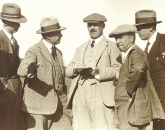The 16th, a short par-four that features a blind tee shot, was made famous by Seve Ballesteros who played his approach from an overflow car park on the right after an errant drive and made birdie. Scott wasn't so lucky. He found the green in two but three-putted from 20 feet for bogey. I somehow avoided all 15 bunkers on the hole and made a par to take a slender lead over my handsome young opponent.
The 17th is a real beast, even by Lytham's exacting standards. A long, dogleg left par-four pockmarked by 20 bunkers, it was here where Scott hoiked his approach left of the green into the gnarliest of rough leaving him absolutely no chance of getting up and down. I, on the other hand, came up short with my 8-rion (after a very satisfying drive down the middle) into what felt like my 50th bunker of the day. A pitch on and two putts meant I headed to the 18th with a one-shot lead. Before getting there, however, each of our group attempted Scott's horror chip from the side of the green. Our combined best effort was a duff into the swale just a few yards ahead. Brutal.
The 18th, where Jacklin hit what Longhurst described as a "corker" down the middle of the fairway to sew up the Open 43 years ago, is not a long finishing hole by modern standards, but with 17 bunkers encroaching into what is an undeniably slender landing area, it demands accuracy. Scott, as we know, found a dreadful lie in one of the many traps up the left side after trying to hit a soft cut that didn't listen. I did precisely the same thing, following him into the exact same bunker. Fortunately for me, my ball was sitting in the middle of the steep-sided pit and I was able to advance it forward. Scott in fact did brilliantly to even get his ball out, something which was overshadowed by the hubbub of his scarcely believable implosion.
Scott, of course, would fire a good approach to 12 feet but pulled his putt a fraction to miss out on a play-off with his good friend Els. Once again I hit a needlessly aggressive approach but this time I got away with it, my 9-iron holding its line to end up between the pin and a yawning greenside bunker just five yards away. One putt later and I had made one of the best pars of my life. I had covered the back-nine in seven-over for a total of 85. And just as importantly – to me at least – I had nipped the desperately unfortunate Scott by two over the closing holes.
Walking back to the clubhouse (after failing an attempt at holing the putt Els did to really win the Open) I realised I had played 18 holes of one of the hardest courses on the planet without losing a ball – something I have never achieved at Kau Sai Chau. I was delighted.
Playing Lytham in such conditions and at such a time was literally a dream come true. The great golf writer Bernard Darwin once described the course as “a beast of a course, but a just beast” – and I have to agree. It was perhaps the most fun I’ve ever had playing and I can only pray I get the chance to do so again one day.
Pages
Click here to see the published article.











